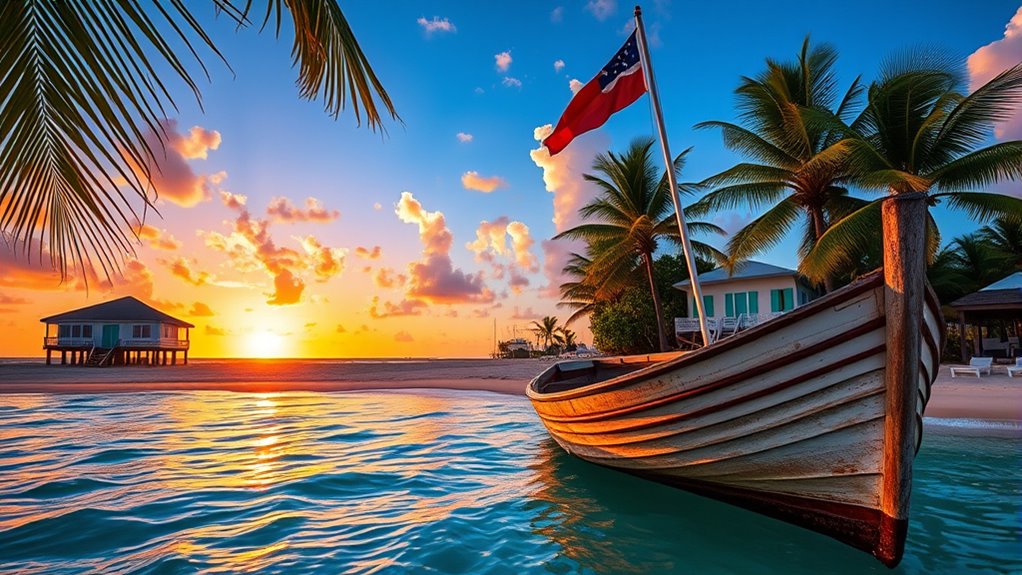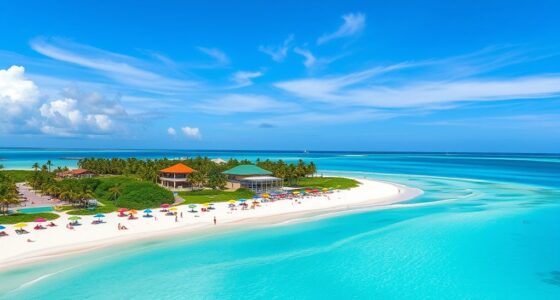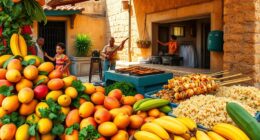The history and culture of the Cayman Islands are shaped by early explorers, who named the islands after local wildlife like turtles, alligators, and marine crocodiles. Over time, they evolved from British colonial roots into a thriving self-governing territory with a strong economy driven by tourism and finance. Their vibrant Caribbean, British, and African heritage influences music, food, and traditions. If you continue exploring, you’ll discover even more about their unique story and cultural richness.
Key Takeaways
- The islands were originally named for local wildlife, evolving from Las Tortugas to Caymanes, reflecting indigenous and European influences.
- Cayman Islands became a British Overseas Territory in 1962, with a history of slavery abolition and early reliance on farming and turtle trade.
- Self-governance developed through a 1959 constitution and an internal Legislative Assembly established in 1972.
- Tourism and offshore finance sectors significantly boosted the economy, with cultural influences from Caribbean, British, and African traditions.
- Environmental conservation, including marine protected areas, plays a vital role in preserving natural heritage and promoting sustainable tourism.
Early Discoveries and Name Evolution
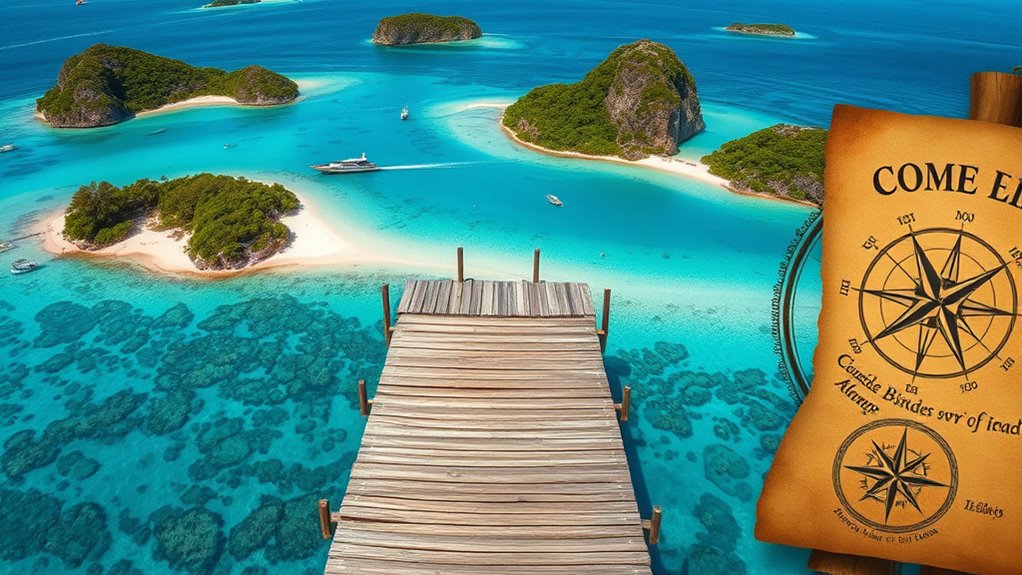
The story of the Cayman Islands begins with their European discovery when Christopher Columbus first sighted them on May 10, 1503. He named the islands *Las Tortugas* because of the many sea turtles he saw. Over time, the islands’ name changed, reflecting local wildlife and language. By 1523, they were called *Los Lagartos*, meaning alligators or lizards, due to the presence of these creatures. Around 1530, the name evolved to *Caymanes*, derived from the Carib word for marine crocodile, highlighting the islands’ connection to sea creatures. These early names reveal how explorers interacted with the islands’ natural environment, and the names stuck, shaping the islands’ identity for centuries. Their history begins with these discoveries and evolving names rooted in wildlife observations. Additionally, the islands’ naming history demonstrates the influence of indigenous terms and European exploration on their cultural identity.
British Colonial Era and Societal Changes

During the British Colonial Era, the Cayman Islands experienced significant societal and political shifts that shaped their future. You saw the islands governed as part of Jamaica until 1962, when they became a separate Crown colony. Slavery was abolished in 1834, transforming social dynamics and labor systems. The population grew steadily, with early settlements emerging on Little Cayman and Cayman Brac. Economically, you relied on farming, turtle trade, and wood harvesting. The 1794 wreck of ten ships became a local legend, highlighting community resilience. Over time, you gained more autonomy, especially after the 1959 constitution granted women voting rights. Despite Jamaica’s independence, you chose to remain under British rule, setting the foundation for self-governing institutions and a distinct identity. The development of self-governing institutions further reinforced your sovereignty and cultural heritage.
Development of Self-Governance and Political Structure
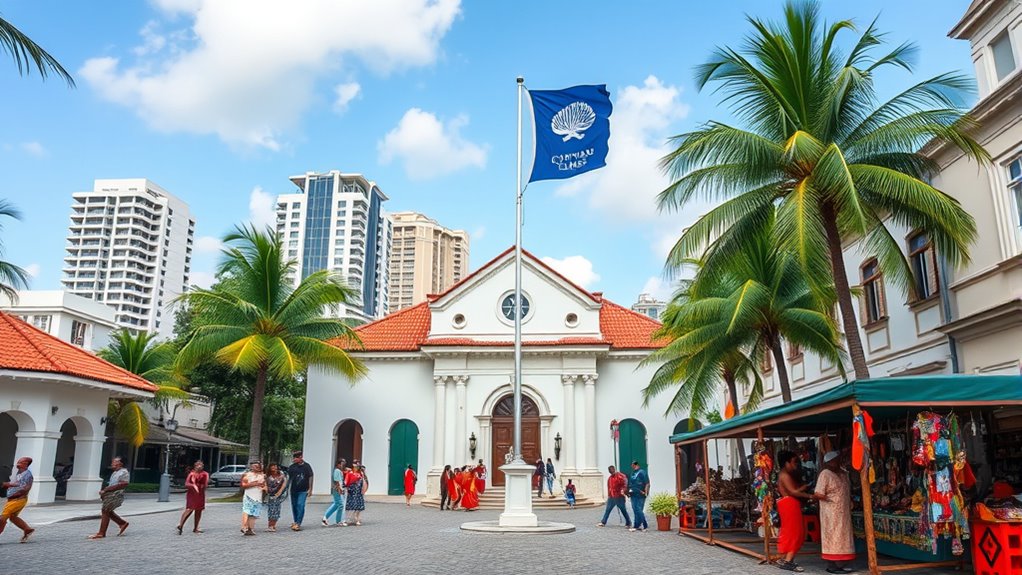
As the Cayman Islands moved toward greater autonomy, their political landscape began to evolve beyond colonial oversight. In 1959, they adopted their first written constitution, giving women voting rights. By 1972, a new constitution established internal self-governance, creating a Legislative Assembly to pass laws and manage local affairs. The Governor, appointed by Britain, still represented the Crown but delegated authority to locally elected officials. After Jamaica gained independence in 1962, the Cayman Islands chose to remain a British Overseas Territory, strengthening their self-governance. Over time, they expanded political participation, developing a stable government structure that balances local decision-making with British oversight. Today, you see a well-established political system, emphasizing local leadership within the framework of a constitutional monarchy, supported by technological integration to enhance governance and civic engagement.
Economic Growth, Tourism, and Financial Sector
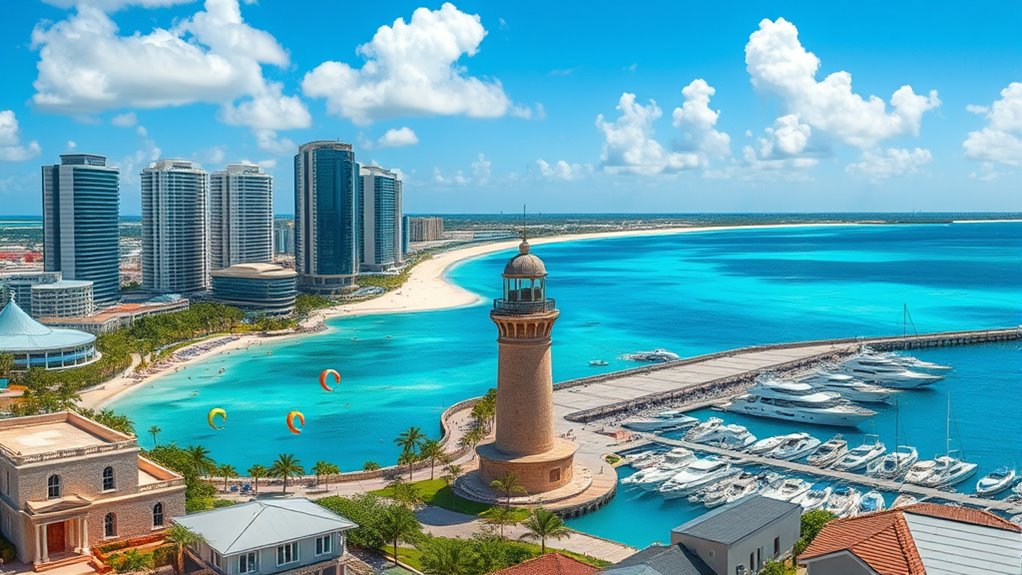
Economic growth in the Cayman Islands has been driven largely by a thriving tourism industry and a robust financial sector. You’ll notice that tourism took off in the 1950s, especially after Owen Roberts International Airport opened, making travel easier. Visitors flock here for pristine beaches, diving, and luxury resorts. Meanwhile, the financial sector grew rapidly after landmark legislation in 1966, transforming the islands into an offshore banking hub. You’ll find many international banks and investment firms operating under favorable tax laws. The government also established Cayman Airways in 1968 to support tourism and business travel. As a result, the islands enjoy a high GDP per capita, with 2023 figures reaching $97,750. This combination of tourism and finance continues to be the backbone of the islands’ vibrant economy. Additionally, the promotion of financial services has attracted a diverse range of global investors, further strengthening the sector.
Cultural Heritage and Environmental Conservation

The Cayman Islands’ rich cultural heritage reflects a vibrant blend of Caribbean, British, and African influences that shape everyday life. You’ll notice this mix in local music, food, and community traditions, which celebrate resilience and diversity. Environmental conservation plays a crucial role in maintaining the islands’ natural beauty. As a visitor or resident, you’re encouraged to support marine protection efforts, such as the marine protected areas established in 1986, and to respect local wildlife like sea turtles. The government actively promotes sustainable tourism, ensuring that economic growth doesn’t harm ecosystems. You can participate by practicing responsible snorkeling, avoiding litter, and supporting eco-friendly initiatives. Preserving both cultural traditions and natural resources helps sustain the islands’ unique identity for future generations. Additionally, many local initiatives utilize WordPress platform tools to raise awareness and educate the community about conservation efforts.
Frequently Asked Questions
What Are the Traditional Caymanian Crafts and Arts?
You’ll find traditional Caymanian crafts and arts deeply rooted in the islands’ heritage. You can craft intricate woven baskets, mats, and fans from palm leaves, showcasing skill and resourcefulness. You might also see vibrant wood carvings, often depicting local marine life or cultural symbols. Additionally, you’ll notice colorful quilting and sewing of traditional garments, reflecting the island’s rich cultural blend and craftsmanship passed down through generations.
How Do Local Festivals Reflect Cayman Islands’ History?
You’ll see that local festivals in the Cayman Islands celebrate your rich history and diverse influences. During these events, you’ll experience traditional music, dance, and crafts that honor the islands’ Caribbean, British, and African roots. Festivals like Pirates Week highlight the pirate era, while others showcase fishing, Turtle Festival, and cultural performances that connect you to the islands’ resilient past and vibrant community spirit.
What Role Did Indigenous Peoples Play in Early Cayman History?
You might think indigenous peoples played a minor role, but their influence was profound. They first inhabited the islands, shaping early resource use and navigation skills, which laid the groundwork for future settlers. Their knowledge of the land and sea helped sustain the community. Even though their presence was eventually overshadowed, their legacy lives on in local traditions and the islands’ cultural foundations, making their contribution truly monumental.
How Has Immigration Shaped Caymanian Cultural Identity?
Immigration has profoundly shaped your Caymanian cultural identity by introducing diverse traditions, languages, and practices from over 140 countries. You experience a vibrant multicultural community where Caribbean, British, and African influences blend seamlessly. This diversity fosters resilience, adaptability, and a unique sense of belonging. You celebrate festivals that reflect your multicultural roots, and your community’s openness and inclusiveness are direct results of the rich immigrant history that continues to influence your daily life.
What Are Unique Environmental Challenges Facing the Islands Today?
You might not realize it, but the Cayman Islands face urgent environmental challenges that threaten their stunning ecosystem. Rising sea levels and climate change cause erosion and threaten marine habitats, while increasing tourism puts pressure on fragile ecosystems. Coral reefs suffer from pollution and warming waters, risking biodiversity. If you care about preserving this paradise, understanding these threats is vital to support sustainable efforts and protect the islands’ natural beauty for generations to come.
Conclusion
As you explore the Cayman Islands’ rich history, you’ll see how their culture has evolved through discovery, colonial influence, and modern prosperity. Some believe the islands’ name derives from the Carib word for “crocodile,” reflecting their early encounters with nature. Today, you can enjoy vibrant traditions while knowing the islands actively preserve their environment and heritage. This blend of history and innovation truly makes the Cayman Islands a unique and resilient place to experience.

